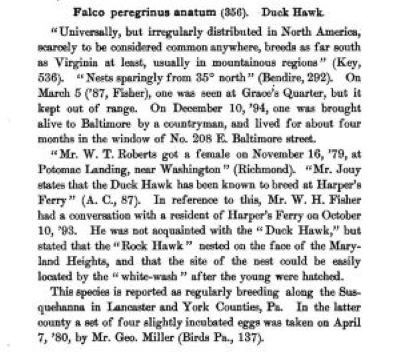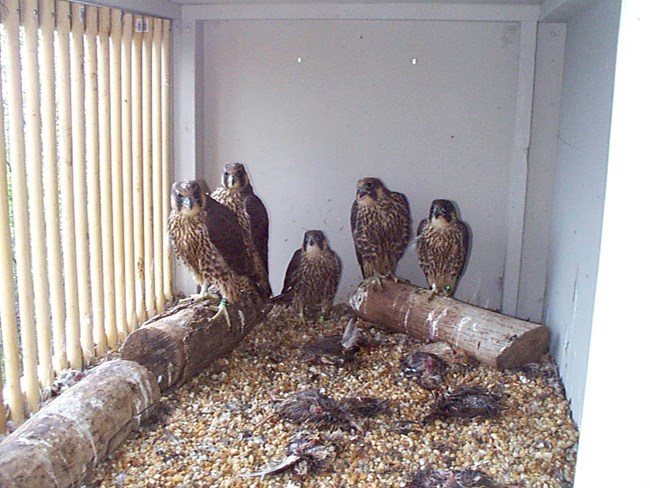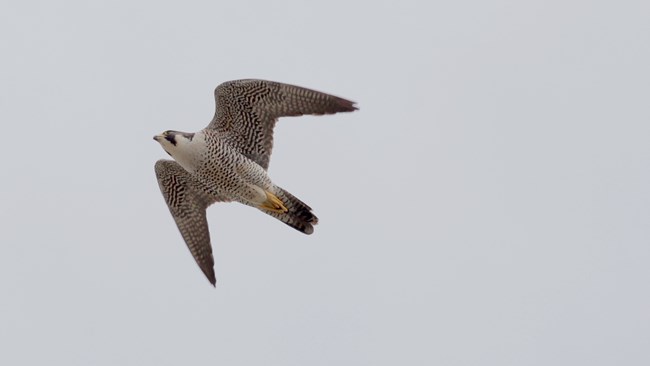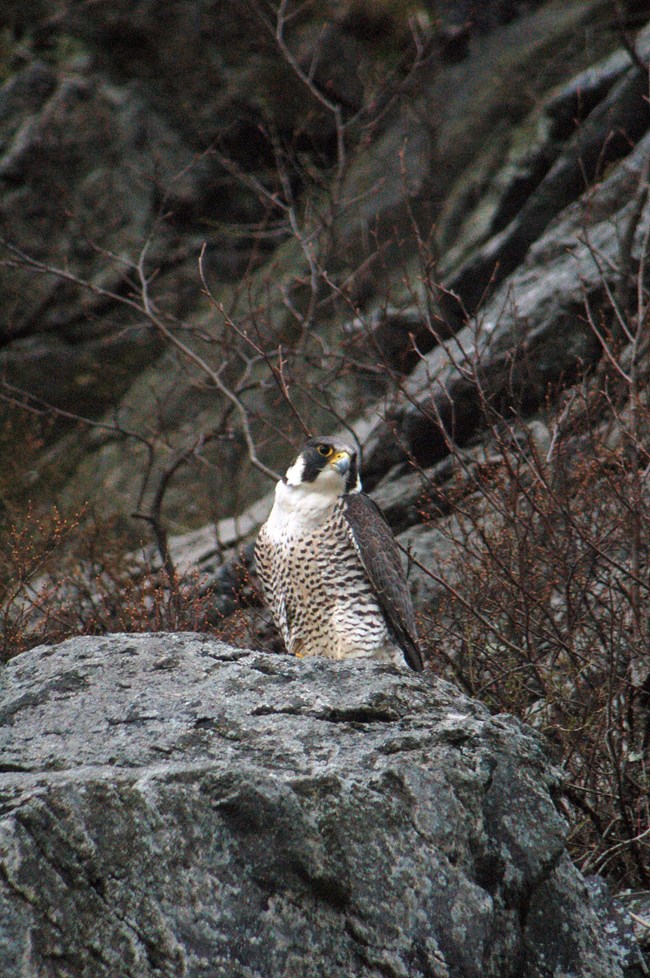Last updated: January 15, 2020
Article
Peregrine Falcons return to Harpers Ferry National Historical Park

NPS Photo

from the book "A List of the Birds of Maryland" (1895)
History of peregrine falcons at Harpers Ferry
The last time a pair of peregrine falcons (Falco peregrinus) nested on the cliffs of Maryland Heights across the Potomac River from the historic town of Harpers Ferry, the area looked much different. Land was still being acquired for the new Harpers Ferry National Monument, restoration of Lower Town buildings was just beginning, and a hiking trail on Maryland Heights did not yet exist.According to Brian McDonald, a Washington, D.C., native who became active in the sport of falconry in the 1940s, a peregrine pair nesting on the iconic crag with an advertisement painted on its face hatched three chicks – two males and a female – in 1950.
At the time, this falcon nest, or eyrie, was one of the most famous in the eastern U.S., known to falconers, egg collectors, and naturalists and referenced in several popular and scientific publications, including Birds Over America (1948), the first full-length book by famed ornithologist Roger Tory Peterson.
It was also the last productive peregrine eyrie known in Maryland, as the species vanished from the state, the entire eastern U.S., and most of North America, the U.K., and Europe throughout the mid-twentieth century as a result of reproductive failure caused by the organochlorine pesticide DDT, which inhibited the birds’ ability to metabolize calcium, causing them to lay thin-shelled eggs that cracked prior to hatching.
Releasing falcons in Maryland
A captive-breeding program was initiated by ornithologists and falconers in 1970, and the first reintroduction of captive-bred peregrines in Maryland occurred five years later, when four young falcons were released from a tower within the U.S. Army’s Aberdeen Proving Ground on Carroll Island in the Chesapeake Bay.
In total, 90 falcons were released in Maryland between 1975 and 1984, part of a continent-wide effort that saw the reintroduction of more than 6,000 captive-bred peregrines throughout the U.S. between 1974 and 1997.
Although Maryland Heights was considered a prime nest site and was known to have been occupied by peregrines since at least the 1880s, it was not chosen as a release site during the initial reintroduction because scientists discovered early on that young falcons released at natural sites in lower elevations, lacking the protection of adult birds, were vulnerable to predation, particularly by great-horned owls (Bubo virginianus).
Thus, all of the peregrines reintroduced in Maryland and most in other mid-Atlantic states were released either from specially designed towers within the Coastal Plain or other man-made structures in urban areas, where young falcons faced other threats but benefited from fewer natural predators and an abundance of the small- to medium-sized birds that are the peregrine’s primary prey.
It was initially hoped that falcons released in these areas, or their progeny, would move inland and reoccupy the natural cliffs that serve as the birds’ typical nesting sites throughout their cosmopolitan range.
Although falcons did recolonize cliffs in the Northeast and some parts of the southern Appalachians where the majority of releases occurred at or near natural sites, they have been slow to return to most of their historic range elsewhere throughout the Appalachian chain. Despite a recent resurgence in some of those areas, the majority of the eastern peregrine population still nests on man-made structures or in urban areas, taking advantage of an ecological niche created in a landscape vastly altered by humans.

NPS Photo
Harpers Ferry National Historical Park was one of three release sites chosen, along with Shenandoah National Park in Va. and the New River Gorge in W.Va.
Through that project, which was a collaborative effort between the CCB, NPS, U.S. Fish & Wildlife Service, Md. Dept. of Natural Resources, and other partners, about 30 falcons were released at Harpers Ferry between 2001 and 2005.
Although none of the falcons reintroduced in the park returned to breed there, a male released in the New River Gorge in 2007 frequented the Harpers Ferry area and ultimately established a new territory in an active quarry in nearby Millville, W.Va.

NPS Photo/Volunteer J. Kelly
Recent history of peregrine falcons on Maryland Heights
Sightings of individual falcons in the park increased over the next several years, but none of those birds took up permanent residence on Maryland Heights until 2015, when an adult female was observed regularly. Several adult males were also seen that year and the next, but unfortunately no breeding attempts were made, and those birds eventually disappeared.Then in December 2018, a local birder spotted an adult male peregrine frequenting a ledge on the cliff near the faded old sign. He attracted a new adult female and the pair were seen courting and investigating potential nest ledges, but hopes for the first successful nesting in the park in nearly 70 years were dashed when the male vanished in early April.
The carcass of a male peregrine was found four days later on a nearby campground with injuries consistent with a strike from another peregrine, so park officials speculate the male may have been killed in a territorial interaction with one of the falcons from the nearby quarry.
The female and an immature male falcon were observed in the park into the summer, but again, no breeding attempts were made, and those falcons eventually dispersed as well.
Hope springs eternal, though, and those of park officials soared once again as a new peregrine pair was observed hunting and defending territory in late 2019 and early 2020.

NPS Photo/Volunteer M. Olear
How you can be involved
In addition to observing seasonal closures, members of the public can assist the falcons and contribute to this long-hoped-for milestone by volunteering to help monitor the birds or serve as educational interpreters. Visit the park’s Contact Us web page to email park staff to ask about being involved.
Be sure to watch the park’s website (nps.gov/hafe) and social media (@HarpersFerryNPS) like a hawk for photos, updates, and #falconfriday fun facts throughout spring and summer.
